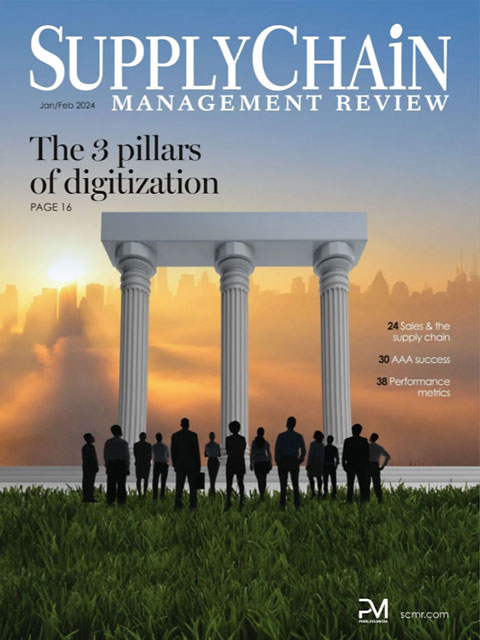Sorry, but your login has failed. Please recheck your login information and resubmit. If your subscription has expired, renew here.
January-February 2024
Back in 2019, we seemed on a consistent path to the future. Then COVID-19 arrived on the global scene, and all predictions went out the window. As 2024 begins, everyone wants to know what the year will look like. I predict continued interest in circular supply chains, cybersecurity, visibility, and digital supply chains, to name a few. But I am not alone. So, I’d like to share five things that I am particularly interested in this year. Browse this issue archive.Need Help? Contact customer service 847-559-7581 More options
“In war, only the simple succeeds.” – Paul von Hindenburg, president of Germany’s Weimar Republic
You can buy or build all the technology you want and mandate all the cybersecurity and digital training in the world, but unless you have digitally savvy leaders, your efforts to secure your supply chain and make it more resilient will fall flat. This leadership change entails challenging our narratives about users and boosting the adoption of digital tools. Most business leaders don’t truly understand the power and impact of digital. If they did, they would recognize it as an existential threat and also a growth opportunity. Instead, many organizations remain stuck doing things as they’ve always done. This isn’t necessarily bad, but it becomes problematic when trying to change the enterprise and initiate a digital-first way of operating.
The digital upskilling of people can change an organization’s trajectory. Yet, it’s often distilled to the minimum: taking some learning management courses and doing a big system upgrade and/or consolidation. What’s more, digital transformations are often big and complicated, so there are great opportunities for poor performers to hide. Even worse, they can be active blockers to success. Or you will see employees adopt the language du jour to protect themselves. (For instance, the person who once built reports is now a “data scientist,” which is nonsense.)
The scope is a huge issue as well. Often, digital transformations are too big to manage, with leaders wrongly focused on activity, not productivity. A big digital transformation requires an agile way of working to increase success and limit risk. So why is the transformation itself a complicated and monolithic waterfall that’s almost guaranteed to lead to failure? (I blame executive desires for a big bang and consultants for perpetuating this.) Most digital transformations are too reliant on storytelling and promoting. The “why” is usually well-articulated, but the “what” and “how” are always missing.
Disrupting the deficit perspective
There’s something so gratifying about studying a particular topic and discovering new patterns. As I started traveling after the pandemic, I noticed significantly more digital competency and maturity within organizations. That made sense. However, I was surprised to hear nearly every analyst/consultant/solution provider say procurement was broken. I heard the following over and over:
Procurement …
- “has no real control over the category, is remote from every purchase and has no analytics or insights to effect change or improvements.”
- “continues to run many activities manually, using traditional technology.”
- “has no visibility into spend.”
- “is backward-looking reporting; there’s no forecasting.”
- “struggles to be influential in business decisions.”

This complete article is available to subscribers only.
Log in now for full access or start your PLUS+ subscription for instant access.
SC
MR
Sorry, but your login has failed. Please recheck your login information and resubmit. If your subscription has expired, renew here.
January-February 2024
Back in 2019, we seemed on a consistent path to the future. Then COVID-19 arrived on the global scene, and all predictions went out the window. As 2024 begins, everyone wants to know what the year will look like. I… Browse this issue archive. Access your online digital edition. Download a PDF file of the January-February 2024 issue.“In war, only the simple succeeds.” – Paul von Hindenburg, president of Germany’s Weimar Republic
You can buy or build all the technology you want and mandate all the cybersecurity and digital training in the world, but unless you have digitally savvy leaders, your efforts to secure your supply chain and make it more resilient will fall flat. This leadership change entails challenging our narratives about users and boosting the adoption of digital tools. Most business leaders don’t truly understand the power and impact of digital. If they did, they would recognize it as an existential threat and also a growth opportunity. Instead, many organizations remain stuck doing things as they’ve always done. This isn’t necessarily bad, but it becomes problematic when trying to change the enterprise and initiate a digital-first way of operating.
The digital upskilling of people can change an organization’s trajectory. Yet, it’s often distilled to the minimum: taking some learning management courses and doing a big system upgrade and/or consolidation. What’s more, digital transformations are often big and complicated, so there are great opportunities for poor performers to hide. Even worse, they can be active blockers to success. Or you will see employees adopt the language du jour to protect themselves. (For instance, the person who once built reports is now a “data scientist,” which is nonsense.)
The scope is a huge issue as well. Often, digital transformations are too big to manage, with leaders wrongly focused on activity, not productivity. A big digital transformation requires an agile way of working to increase success and limit risk. So why is the transformation itself a complicated and monolithic waterfall that’s almost guaranteed to lead to failure? (I blame executive desires for a big bang and consultants for perpetuating this.) Most digital transformations are too reliant on storytelling and promoting. The “why” is usually well-articulated, but the “what” and “how” are always missing.
Disrupting the deficit perspective
There’s something so gratifying about studying a particular topic and discovering new patterns. As I started traveling after the pandemic, I noticed significantly more digital competency and maturity within organizations. That made sense. However, I was surprised to hear nearly every analyst/consultant/solution provider say procurement was broken. I heard the following over and over:
Procurement …
- “has no real control over the category, is remote from every purchase and has no analytics or insights to effect change or improvements.”
- “continues to run many activities manually, using traditional technology.”
- “has no visibility into spend.”
- “is backward-looking reporting; there’s no forecasting.”
- “struggles to be influential in business decisions.”
SC
MR


Latest Supply Chain News
- 6 Questions With … Sandeep Bhide
- MIT CTL offering humanitarian logistics course
- Bridging the ESG gap in supply chain management: From ambition to action
- Few executives believe their supply chains can respond quickly to disruptions
- Technology’s role in mending supply chain fragility after recent disruptions
- More News
Latest Podcast

 Explore
Explore
Software & Technology News
- Technology’s role in mending supply chain fragility after recent disruptions
- Tech investments bring revenue increases, survey finds
- Survey reveals strategies for addressing supply chain, logistics labor shortages
- AI, virtual reality is bringing experiential learning into the modern age
- Humanoid robots’ place in an intralogistics smart robot strategy
- Tips for CIOs to overcome technology talent acquisition troubles
- More Software & Technology
Latest Software & Technology Resources

Subscribe

Supply Chain Management Review delivers the best industry content.

Editors’ Picks






